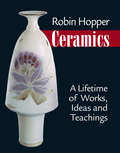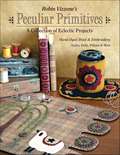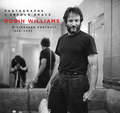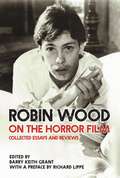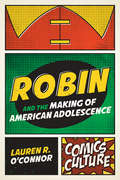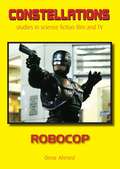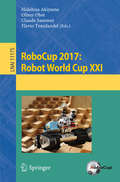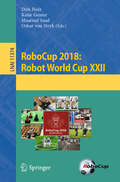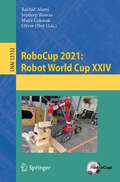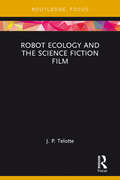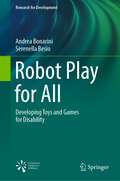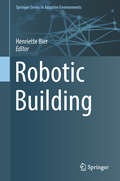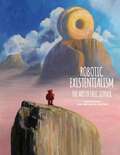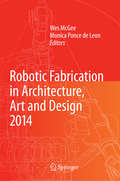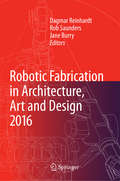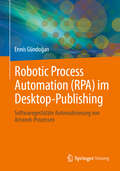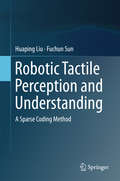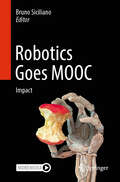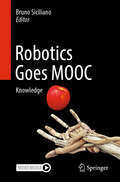- Table View
- List View
Robin Boyd: Spatial Continuity
by Louise Wright Mauro BaraccoAustralian architect Robin Boyd (1919–1971) advocated tirelessly for the voice of Australian architects so that there could be an architecture that might speak to Australian conditions and sensibilities.His legacy continues in the work of contemporary Australian architects yet also prompts a way forward for architecture particularly in relationship to the landscapes they inhabit through a quality of continuous space found in his work where the buildings are spatially reliant and sympathetic to the places they occupy. A selection of 22 projects are documented comprehensively in this book for the first time. This slice through Boyd’s body of work reveals a gifted, complex and contemporary thinker.
Robin Hopper Ceramics: A Lifetime of Works, Ideas and Teachings
by Robin HopperLearn the art of ceramics with a master! Step into the studio with master artist Robin Hopper as he opens the door to his more than 50-year exploration of ceramics in Robin Hopper Ceramics. Discover the "hows" and "whys" behind Robin's artistry while he shares his innovative insight, personal reflection and life's work. Robin Hopper Ceramics paints an intriguing self-portrait of the man within the legendary artist, teacher and arts activist as it urges artists to push themselves further in their work. More than 400 photos and illustrations showcase finished pieces, ideas and instructions ceramists can easily apply to their own work. Join Robin as he inspires and instructs artists on topics including form, surface, function, design, development and themes. This is the one autobiography that all ceramic artists should have in their studios to exhilarate, educate and encourage them to explore!
Robin Vizzone's Peculiar Primitives: A Collection of Eclectic Projects
by Robin VizzoneStitches that tell a story Primitive lines harken back to our American roots, reminding us of simpler times. Embrace the beauty of hand stitching with whimsical, age-worn designs. From wall quilts to table toppers and primitive dolls to pincushions, you'll sew 12 handcrafted projects with eccentric flair and distinct character—ideal for both beginners and more experienced sewists. Your stitches are meant to tell a story, so put perfection to the side as you create memories with felted wool, distressed cottons, and embroidery thread. • Sew 12 eclectic designs using felted wool appliqué and hand embroidery • Embrace perfectly imperfect construction that truly embodies the primitive look • Savor slow sewing while making handmade gifts for those you love
Robin Williams Design Workshop (2nd Edition)
by Robin Williams John TollettLearn design theory and practical know-how from the award-winning author/design team, Robin Williams and John Tollett! Robin Williams introduced design and typographic principles to legions of readers with her best-selling Non-Designer's book series. Now she and designer/co-author John Tollett take you to the next level of creative design with practical advice and lessons in composition, visual impact, and design challenges. Presented in Robin and John's signature style--writing that is so crystal clear, it's accessible to absolutely anyone--and illustrated with hundreds of full-color design examples, the ideas in this book tackle design theory, visual puns, and layout and graphics strategies for real-world projects. Developing designers will appreciate the authors' imaginative approach and well-chosen examples. Discover practical and effective design principles and concepts--and how to apply them to virtually any project. Learn why some designs are attention-getting and others are not. Learn how to choose just the right look--corporate or casual, classic or trendy--for specific types of projects, such as business cards, letterhead and envelopes, newsletters and brochures, logos, advertising, and more. Test your design acumen by comparing before-and-after examples. Find a wealth of inspiration for your own design projects. Gain insight into the design process by studying the work of guest designers, who offer their personal commentary and insights.
Robin Williams: A Singular Portrait, 1986-2002
by Arthur GraceI had always thought that when I was around 84 and Robin was 80 we could collaborate on a book about the golden years of his career where he could look at my photographs and reminisce about the events and his feelings at the time. Unfortunately, that book was never to be . . . .Photographer Arthur Grace first met Robin Williams in April 1986, at a comedy club in Pittsburgh where Williams was working to polish what would eventually become his award-winning special "Evening at the Met". The two hit it off immediately, and thus blossomed a close friendship that carried them through their increasingly successful careers. Told through a series of stunning photographs of Williams taken by Grace over the course of this decades-long partnership, Robin Williams: A Singular Portrait offers a touching and up-close look at the real Robin Williams-the manic and happy, the pensive and weary, the engaged and disengaged, a true portrait of one of America's greatest comics and most beloved actors.For the millions of people around the globe that Robin Williams has touched, these images, more than 150 photographs, a glorious mixture of stunning color and resonating black and white presented in exhibit format, will be something to embrace and cherish, not simply because of their exclusivity, but because of their intimacy and their honesty.
Robin Wood on the Horror Film: Collected Essays and Reviews (Contemporary Approaches to Film and Media Series)
by Barry Keith Grant Robin Wood Richard LippeRobin Wood—one of the foremost critics of cinema—has laid the groundwork for anyone writing about the horror film in the last half-century. Wood’s interest in horror spanned his entire career and was a form of popular cinema to which he devoted unwavering attention. Robin Wood on the Horror Film: Collected Essays and Reviews compiles over fifty years of his groundbreaking critiques. In September 1979, Wood and Richard Lippe programmed an extensive series of horror films for the Toronto International Film Festival and edited a companion piece: The American Nightmare: Essays on the Horror Film — the first serious collection of critical writing on the horror genre. Robin Wood on the Horror Film now contains all of Wood’s writings from The American Nightmare and nearly everything else he wrote over the years on horror—published in a range of journals and magazines—gathered together for the first time. It begins with the first essay Wood ever published, "Psychoanalysis of Psycho," which appeared in 1960 and already anticipated many of the ideas explored later in his touchstone book, Hitchcock’s Films. The volume ends, fittingly, with, "What Lies Beneath?," written almost five decades later, an essay in which Wood reflects on the state of the horror film and criticism since the genre’s renaissance in the 1970s. Wood’s prose is eloquent, lucid, and convincing as he brings together his parallel interests in genre, authorship, and ideology. Deftly combining Marxist, Freudian, and feminist theory, Wood’s prolonged attention to classic and contemporary horror films explains much about the genre’s meanings and cultural functions. Robin Wood on the Horror Film will be an essential addition to the library of anyone interested in horror, science fiction, and film genre.
Robin and the Making of American Adolescence (Comics Culture)
by Lauren R. O'ConnorHoly adolescence, Batman! Robin and the Making of American Adolescence offers the first character history and analysis of the most famous superhero sidekick, Robin. Debuting just a few months after Batman himself, Robin has been an integral part of the Dark Knight’s history—and debuting just a few months prior to the word “teenager” first appearing in print, Robin has from the outset both reflected and reinforced particular images of American adolescence. Closely reading several characters who have “played” Robin over the past eighty years, Robin and the Making of American Adolescence reveals the Boy (and sometimes Girl!) Wonder as a complex figure through whom mainstream culture has addressed anxieties about adolescents in relation to sexuality, gender, and race. This book partners up comics studies and adolescent studies as a new Dynamic Duo, following Robin as he swings alongside the ever-changing American teenager and finally shining the Bat-signal on the latter half of “Batman and—.”
RoboCop (Constellations)
by Omar AhmedRoboCop was Dutch director Paul Verhoeven's first American film, and was both a commercial and (surprise) critical hit on release in 1987. Marking its thirtieth anniversary, this volume explores the film from a variety of critical approaches, including re-reading RoboCop as a Western; the neo-fascist corporatization of the human body; satire, late-Reagan America and the rise of neo-liberalism; resurrection, death, and the figure of the cyborg in science fiction; and the legacy of the film across American cinema and within Verhoeven's own body of work, which includes Total Recall and Starship Troopers, both of which develop further ideological interests about American culture. "I'd buy that for a dollar!"
RoboCup 2017: Robot World Cup XXI (Lecture Notes in Computer Science #11175)
by Claude Sammut Hidehisa Akiyama Oliver Obst Flavio TonidandelThis book includes the post-conference proceedings of the 21st RoboCup International Symposium, held in Nagoya, Japan, in September 2017. The 33 full revised papers and 9 papers from the winning teams presented were carefully reviewed and selected from 58 submissions. The papers are orginazed on topical sections on Robotics, Artificial intelligence, Environment perception, State estimation and much more.
RoboCup 2018: Robot World Cup XXII (Lecture Notes in Computer Science #11374)
by Dirk Holz Katie Genter Maarouf Saad Oskar Von StrykThis book includes the post-conference proceedings of the 22nd RoboCup International Symposium, held in Montreal, QC, Canada, in June 2018. The 32 full revised papers and 11 papers from the winning teams presented were carefully reviewed and selected from 51 submissions. This book highlights the approaches of champion teams from the competitions and documents the proceedings of the 22nd annual RoboCup International Symposium. Due to the complex research challenges set by the RoboCup initiative, the RoboCup International Symposium offers a unique perspective for exploring scientific and engineering principles underlying advanced robotic and AI systems.
RoboCup 2019: Robot World Cup XXIII (Lecture Notes in Computer Science #11531)
by Mary-Anne Williams Stephan Chalup Tim Niemueller Jackrit SuthakornThis book includes the post-conference proceedings of the 23rd RoboCup International Symposium, held in Sydney, NSW, Australia, in July 2019. The 38 full revised papers and 14 invited papers presented in this book were carefully reviewed and selected from 74 submissions. This book highlights the approaches of champion teams from the competitions and documents the proceedings of the 23rd annual RoboCup International Symposium. Due to the complex research challenges set by the RoboCup initiative, the RoboCup International Symposium offers a unique perspective for exploring scientific and engineering principles underlying advanced robotic and AI systems.
RoboCup 2021: Robot World Cup XXIV (Lecture Notes in Computer Science #13132)
by Oliver Obst Rachid Alami Joydeep Biswas Maya CakmakThis book constitutes the proceedings of the 24th RoboCup International Symposium which was held online during June 22 - June 28, 2021.The 19 full papers included in these proceedings were carefully reviewed and selected from 42 submissions; the volume also includes 10 RoboCup Champions Papers. In addition to presenting the proceedings of the RoboCup 2021 Symposium, the book highlights the approaches of champion teams from the competitions. Due to the complex research challenges set by the RoboCup initiative, the RoboCup International Symposium offers a unique perspective for exploring scientific and engineering principles underlying advanced robotic and AI systems.
Robot Ecology and the Science Fiction Film (Routledge Focus on Film Studies)
by J. P. TelotteThis book offers the first specific application in film studies of what is generally known as ecology theory, shifting attention from history to the (in this case media) environment. It takes the robot as its subject because it has attained a status that resonates not only with some of the key concerns of contemporary culture over the last century, but also with the very nature of film. While the robot has given us a vehicle for exploring issues of gender, race, and a variety of forms of otherness, and increasingly for asking questions about the very nature and meaning of life, this image of an artificial being, typically anthropomorphic, also invariably implicates the cinema’s own and quite fundamental artificing of the human. Looking across genres, across specific media forms, and across closely linked conceptualizations, Telotte sketches a context of interwoven influences and meanings. The result is that this study of the cinematic robot, while mainly focused on science fiction film, also incorporates its appearance in, for example, musicals, cartoons, television, advertising, toys, and literature.
Robot Play for All: Developing Toys and Games for Disability (Research for Development)
by Andrea Bonarini Serenella BesioThis book presents a comprehensive guide to the design of playing robots and the related play experiences. Play is a natural activity for building and improving abilities, and it reveals important particularly for persons with disabilities. Many social, physical and cultural factors may hinder children with disabilities from fully enjoying play as their peers. Autonomous robots with specific characteristics can enhance the ludic experience, having implications for the character of the play and presenting opportunities related to autonomy and physical movement, the very nature of robots. Their introduction into play thus provides everybody, and in particular persons with disabilities, new possibilities for developing abilities, improving general status, participating in social contexts, as well as supporting professionals in monitoring progress. This book presents a framework for the design of playful activities with robots, developed over 20 years’ experience at AIRLab - POLIMI. Part 1 introduces the play concepts and characteristics, and research results about play of children with different kinds of impairments. Part 2 focuses on implementing robots able to play. The design of playful activities is discussed, as well as the necessary characteristics for them to be useful in both general play and activities involving disability-related limitations. In Part 3, the defined framework is used to analyze possibilities involving robots available on the toy market, robots developed at research labs, and robots to be developed in the next future. The aim of the book is to give developers, caregivers, and users a set of methodological tools for selecting, exploring, and designing inclusive play activities where robots play a central role.
Robot Takeover: 100 Iconic Robots of Myth, Popular Culture & Real Life
by Ana MatronicIn the not too distant future, mankind faces the possibility of being overthrown by its own creations.In Robot Takeover, Ana Matronic presents 100 of the most legendary robots and what makes them iconic - their creators, purpose, design and why their existence has shaken, or in some cases, comforted us. Through 100 iconic robots - from Maria in Fritz Lang's Metropolis to the Sentinels of The Matrix and beyond, via the Gunslinger (Westworld), R2-D2 (Star Wars) etc. - this is a comprehensive look at the robot phenomenon. As well as these 100 entries on specific robots, there are features on the people who invent robots, the moral issues around robot sentience, and the prevalence of robots in music, art and fashion, and more. It's the only robot book you need.With fighters, seducers and psychos in their ranks, it's best you get ready for the robot revolution. Know your enemy...
Robotic Building (Springer Series in Adaptive Environments)
by Henriette BierThe first volume of the Adaptive Environments series focuses on Robotic Building, which refers to both physically built robotic environments and robotically supported building processes. Physically built robotic environments consist of reconfigurable, adaptive systems incorporating sensor-actuator mechanisms that enable buildings to interact with their users and surroundings in real-time. These require Design-to-Production and Operation chains that are numerically controlled and (partially or completely) robotically driven. From architectured materials, on- and off-site robotic production to robotic building operation augmenting everyday life, the volume examines achievements of the last decades and outlines potential future developments in Robotic Building.This book offers an overview of the developments within robotics in architecture so far, and explains the future possibilities of this field. The study of interactions between human and non-human agents at building, design, production and operation level will interest readers seeking information on architecture, design-to-robotic-production and design-to-robotic-operation.
Robotic Existentialism: The Art of Eric Joyner
by Eric JoynerIn this follow-up to the 2008 art book Robots and Donuts, vintage toys are paired with pastries to create fascinatingly bizarre paintings.This volume showcases San Francisco-based artist Eric Joyner's newest and most impressive pieces--including The Horseshoe Bend, Daybreak, Movers and Shakers, and more. Much like the subjects of his paintings, Joyner's artistic style is subtly nostalgic yet imaginatively unique. By juxtaposing familiar items with every day foods, he creates whimsical masterpieces that have the power to both comfort and inspire. Robotic Existentialism: The Art of Eric Joyner is a beautiful collection that entices the reader to stop, ponder the meaning of life, and perhaps savor a donut or two.
Robotic Fabrication in Architecture, Art and Design 2014
by Wes Mcgee Monica Ponce de LeonRobotic automation has become ubiquitous in the modern manufacturing landscape, spanning an overwhelming range of processes and applications-- from small scale force-controlled grinding operations for orthopedic joints to large scale composite manufacturing of aircraft fuselages. Smart factories, seamlessly linked via industrial networks and sensing, have revolutionized mass production, allowing for intelligent, adaptive manufacturing processes across a broad spectrum of industries. Against this background, an emerging group of researchers, designers, and fabricators have begun to apply robotic technology in the pursuit of architecture, art, and design, implementing them in a range of processes and scales. Coupled with computational design tools the technology is no longer relegated to the repetitive production of the assembly line, and is instead being employed for the mass-customization of non-standard components. This radical shift in protocol has been enabled by the development of new design to production workflows and the recognition of robotic manipulators as "multi-functional" fabrication platforms, capable of being reconfigured to suit the specific needs of a process. The emerging discourse surrounding robotic fabrication seeks to question the existing norms of manufacturing and has far reaching implications for the future of how architects, artists, and designers engage with materialization processes. This book presents the proceedings of Rob|Arch2014, the second international conference on robotic fabrication in architecture, art, and design. It includes a Foreword by Sigrid Brell-Cokcan and Johannes Braumann, Association for Robots in Architecture. The work contained traverses a wide range of contemporary topics, from methodologies for incorporating dynamic material feedback into existing fabrication processes, to novel interfaces for robotic programming, to new processes for large-scale automated construction. The latent argument behind this research is that the term 'file-to-factory' must not be a reductive celebration of expediency but instead a perpetual challenge to increase the quality of feedback between design, matter, and making
Robotic Fabrication in Architecture, Art and Design 2016
by Dagmar Reinhardt Rob Saunders Jane BurryThe book presents the proceedings of Rob/Arch 2016, the third international conference on robotic fabrication in architecture, art, and design. The work contains a wide range of contemporary topics, from methodologies for incorporating dynamic material feedback into existing fabrication processes, to novel interfaces for robotic programming, to new processes for large-scale automated construction. The latent argument behind this research is that the term 'file-to-factory' must not be a reductive celebration of expediency but instead a perpetual challenge to increase the quality of feedback between design, matter, and making.
Robotic Process Automation (RPA) im Desktop-Publishing: Softwaregestützte Automatisierung von Artwork-Prozessen
by Ennis GündoğanDieses Buch soll dem Leser verschiedene Automatisierungsmöglichkeiten im Bereich Desktop-Publishing aufzeigen und ihn motivieren, diese in Ihren Arbeitsprozess einzube-ziehen, um die Effizienz und Effektivität ihrer Gestaltungs- bzw. Produktionsprozesse zu erhöhen. Die Methoden reichen von kleinen Hilfsmitteln wie in DTP-Software wie Adobe InDesign integrierten Skripten zur automatischen Generierung grafischer Assets bis hin zu komplexen Software-Infrastrukturen, die das automatisierte Publizieren von Tausenden von Dokumenten realisieren. Das Buch soll möglichst viele Szenarien abdecken, ein breites Publikum ansprechen und weitestgehend alle Themen rund um die Automatisierung im Desktop-Publishing kurz und prägnant abdecken. Ebenso soll das Buch mithilfe von Fall-beispielen die Effizienz und Effektivität der Automatisierung verifizieren und mehrere Blickwinkel auf DTP-bezogene Unterthemen bieten.
Robotic Tactile Perception and Understanding: A Sparse Coding Method
by Huaping Liu Fuchun SunThis book introduces the challenges of robotic tactile perception and task understanding, and describes an advanced approach based on machine learning and sparse coding techniques. Further, a set of structured sparse coding models is developed to address the issues of dynamic tactile sensing. The book then proves that the proposed framework is effective in solving the problems of multi-finger tactile object recognition, multi-label tactile adjective recognition and multi-category material analysis, which are all challenging practical problems in the fields of robotics and automation. The proposed sparse coding model can be used to tackle the challenging visual-tactile fusion recognition problem, and the book develops a series of efficient optimization algorithms to implement the model. It is suitable as a reference book for graduate students with a basic knowledge of machine learning as well as professional researchers interested in robotic tactile perception and understanding, and machine learning.
Robotics Goes MOOC: Design
by Bruno SicilianoA robot’s appearance and its way of interacting with humans is of fundamental importance. Until a few years ago there was a clear asymmetry between the typically excellent performance of industrial robots and their ugly and disharmonious bodies, with crude ways and potentially very dangerous movements for the human environment. A modern artifact can be as harmonious and beautiful as a complex biological machine or a work of plastic art and thus it should be clear how design plays a key role for robot technology to become a part of our everyday life and change it essentially in a responsible and beneficial manner. It is designers who shape the interface between humans and machines and, as such, they will contribute to make robots as customizable and intuitively useful to inexperienced users according to a plug-and-play mode. The new concept of robotronics as the mechatronics approach to designing advanced robots is the focus of the first chapter of the second book of the Robotics Goes MOOC project by Asfour et al. The main issues for robot manipulator design are covered in the subsequent material, namely redundant robots in Chapter 2 by Maciejewsky et al and parallel robots in Chapter 3 by Müller, where widely adopted kinematic solutions are presented. Then, the adoption to flexibilty, as opposed to the rigid mechanics paradigm, is discussed in Chapter 4 by Bertram et al with reference to elastic robots and in Chapter 5 by Laschi focused on soft robotics. Somewhat speculating on the previous two design solutions comes Chapter 6 by Cutkosky dealing with bioinspired robots. The last part of the book is devoted to robot locomotion, namely, Chapter 7 by Vendittelli on wheeled robots and Chapter 8 by Harada on (biped) humanoids.
Robotics Goes MOOC: Impact
by Bruno SicilianoIt is often read in the media that AI and Robotics are the primary cause of technology unemployment. AI and machine learning techniques are expected to take over lower-level tasks, while humans can spend more time with higher-level tasks. In perspective, it can be said that jobs requiring boring cognitive tasks or repeatable and dangerous physical tasks will be considerably shredded by automation thanks to the wide adoption of AI & Robotics technology to replace humans, while jobs requiring challenging cognitive tasks or unstructured physical tasks will be suitably re-engineered with the progressive introduction of AI & Robotics technology to assist humans.From the discussion above, it should be clear that in a world populated by humans and robots, issues arise that go beyond engineering and technology due to the impact resulting from the use of robots in various application scenarios. The anthropization of robots cannot ignore the resolution of those ethical, legal, sociological, economic (ELSE) problems that have so far slowed their spread in our society.The final book of the Robotics Goes MOOC project enlightens the impact of using robotic technology in the main fields of application, namely, industrial robots as in Chapter 1 by Bischoff et al, medical robotics as in Chapter 2 by Dario et al, aerial robots as in Chapter 3 by Ollero et al, orbital robotics as in Chapter 4 by Lampariello, underwater robots in Chapter 5 by Antonelli, and rescue robots as in Chapter 6 by Murphy. The last part is devoted to the open dilemma of using and accepting robots in human co-habited environments which is addressed in Chapter 7 on social robotics by Pandey and the very final chapter by Tamburrini on the important issues raised with roboethics.
Robotics Goes MOOC: Interaction
by Bruno SicilianoWith the massive and pervasive diffusion of robotics technology in our society, we are heading towards a new type of AI, which we call Physical AI at the intersection of Robotics with AI, that is the science of robots and intelligent machines performing a physical action to help humans in their jobs of daily lives. Physical assistance to disabled or elderly people; reduction of risks and fatigue at work; improvement of production processes of material goods and their sustainability; safety, efficiency and reduction of environmental impact in transportation of people and goods; progress of diagnostic and surgical techniques are all examples of scenarios where the new InterAction Technology (IAT) is indispensable.The interaction between robots and humans must be managed in a safe and reliable manner. The robot becomes an ideal assistant, like the tool used by a surgeon, a craftsman, a skilled worker. The new generation of robots will co-exist — the cobots— with humans not only in the workplace but, gradually, in homes and communities, providing support in services, entertainment, education, health, manufacturing and care.As widely discussed above, interaction plays a crucial role for the development of modern robotic systems. Grasping, manipulation and cooperative manipulators are covered in the first part of the third book of the Robotics Goes MOOC project, respectively in Chapter 1 by Prattichizzo et al, Chapter 2 by Kao et al, and Chapter 3 by Caccavale. Specific interaction issues along with the development of digital and physical interfaces are dealt with in Chapter 4 by Marchal et al and in Chapter 5 by Croft et al, respectively. Interaction between robot and human also means that a robot can be worn by a human as presented in Chapter 6 by Vitiello et al. A different type of interaction at a cognitive and planning level is the focus of Chapter 7 by Lima devoted to multi-robot systems and Chapter 8 by Song et al on networked, cloud and fog robotics, respectively.
Robotics Goes MOOC: Knowledge
by Bruno SicilianoThe robot “concept” was clearly established by those many creative historical realizations, such as those recalled above. Nonetheless, the emergence of the “physical” robot had to await the advent of its underlying technologies of mechanics, controls, computers, electronics and sensors ―in one word, mechatronics― during the course of the twentieth century. As always, new designs motivate new research and discoveries which, in turn, lead to enhanced solutions and thus to novel concepts. This virtuous circle over time produced that knowledge and understanding which gave birth to the field of Robotics, properly referred to as the science and technology of robots.To make robots and intelligent machines useful to humans it is necessary to have a broad and tight intersection between Robotics and AI. Sophisticated mathematical models are needed that enable the robot from a physical point of view, as well as intelligent algorithms capable of correlating all the information coming from the use of technologically advanced sensors with the data available from experience. It is expected that the synergy of model-based techniques with data-driven approaches will contribute to increasing the level of autonomy of robots and intelligent machines in the near future.The first book of the Robotics Goes MOOC project starts with the journey of robotics in the introductory chapter by Khatib, who has pioneered our field of robotics and has ferried it to the third millennium. Sensing is crucial for the development of intelligent and autonomous robots, as covered in Chapter 2 by Nüchter et al. Model-based control is dealt with in Chapter 3 by Kröeger et al along with motion planning, as well as in Chapter 4 by Villani and Chapter 5 by Chaumette to handle force and visual feedback, respectively, when interacting with the environment. Resorting to AI techniques is the focus of the last part of the book, namely, Chapter 6 by Peters et al on Learning, Chapter 7 byBeetz et al on knowledge representation and reasoning, and Chapter 8 by Burgard et al on graph-based SLAM.

